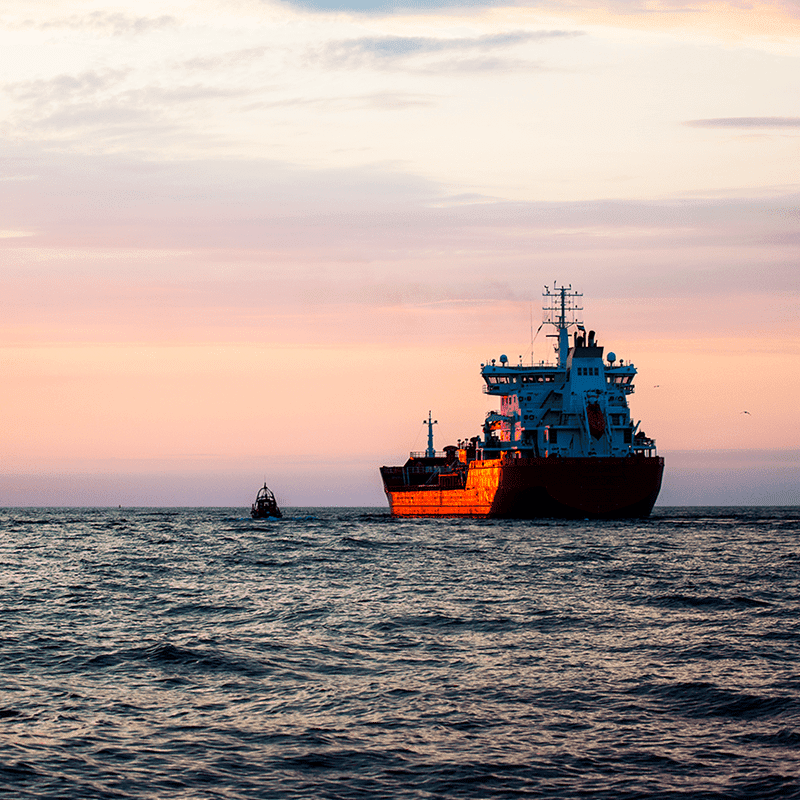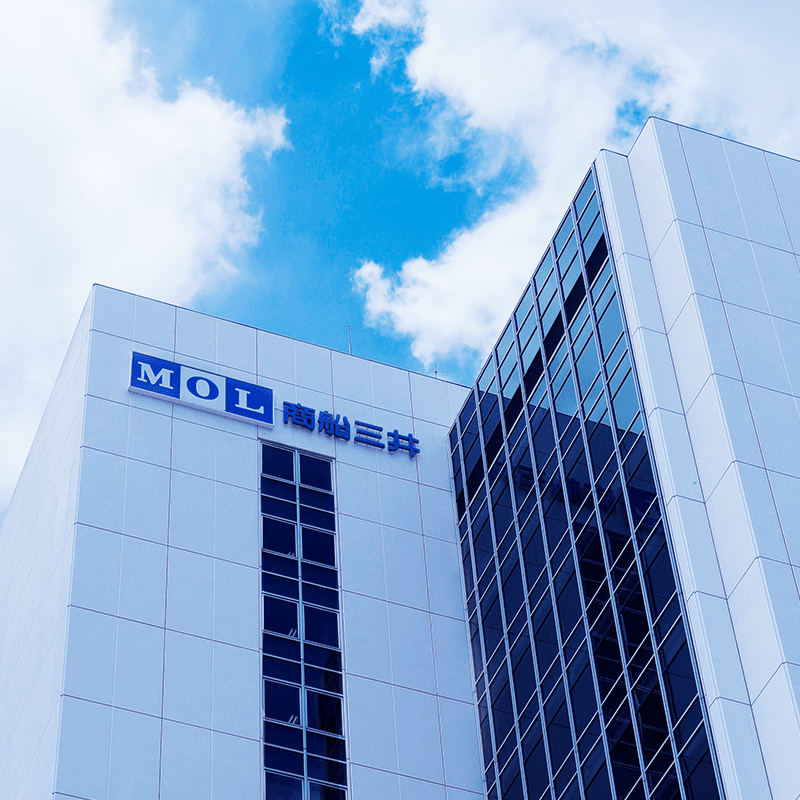BLOG
Global Choke Points (Bottleneck for Maritime Transport) - Panama Canal -
- General Shipping
2024.03.05
To maintain the current globalized supply chain, it is essential that all kinds of cargos around the world continue to be transported without interruption. However, in recent years, the rapidly changing global situation and increasingly severe abnormal weather and climate change have often been highlighted as threats to global maritime cargo transportation. In particular, disruptions or stagnation in cargo transportation at choke points (bottleneck in maritime transport) can immediately cause chaos in the supply chain and have a significant impact on the global economy.
In this blog, we will take a look at one of these choke points, the Panama Canal, which connects the Pacific and Atlantic oceans, where a total of 14,000 ships pass through a year.
What is a Choke Point?
A ‘choke point’ is a concept in geopolitics which refers to a location where an opponent can be "choked" to gain supremacy. Specifically, in a maritime context, it refers to a location where the routes of ships are concentrated at a single point, meaning this location is a bottleneck in maritime transport.
Construction of the Panama Canal
Christopher Columbus, one of the greatest explorers of the Age of Discovery, reached what is now known as the American continent in 1492. About 20 years later, in 1513, Vasco Núñez de Balboa, a Spanish explorer, crossed the Isthmus of Panama, guided by indigenous people. He was the first European to reach the Pacific Ocean. Since then, the idea of constructing a canal connecting the Pacific and Atlantic Oceans was repeatedly considered. In fact, in 1881, Ferdinand de Lesseps, a French diplomat and entrepreneur who had successfully built the Suez Canal, established the Panama Canal Company and began construction of the Panama Canal. However, due to the spread of malaria and yellow fever, as well as the unpredictably difficult construction circumstances, the project did not proceed as originally planned. In 1889, the Panama Canal Company went bankrupt due to a lack of funds and the construction of the canal by Lesseps failed.
Since then, the idea of constructing a canal connecting the Pacific and Atlantic Oceans was repeatedly considered. In fact, in 1881, Ferdinand de Lesseps, a French diplomat and entrepreneur who had successfully built the Suez Canal, established the Panama Canal Company and began construction of the Panama Canal. However, due to the spread of malaria and yellow fever, as well as the unpredictably difficult construction circumstances, the project did not proceed as originally planned. In 1889, the Panama Canal Company went bankrupt due to a lack of funds and the construction of the canal by Lesseps failed.
Construction of the Panama Canal now in operation began in 1904, when the United States signed the Panama Canal Treaty (generally known as the “Hay–Bunau-Varilla Treaty”) with the Republic of Panama, which was founded in 1903. The United States obtained concessions for construction and land related to the canal and resumed the work that Lesseps had failed to complete. Although the resumed work was initially troubled by the spread of infectious diseases and frequent landslides, the United States invested over 300 million dollars, and after approximately a decade of work finally complete the Panama Canal in August 1914, connecting the Pacific and Atlantic Oceans in Panama.
Structure of the Panama Canal and the Panamax Vessel
 In the construction of the Panama Canal, significant challenges were posed by the large tidal differences at both ends of the canal and the mountainous geography of the proposed construction site.
In the construction of the Panama Canal, significant challenges were posed by the large tidal differences at both ends of the canal and the mountainous geography of the proposed construction site.
Therefore, to solve these problems, the Panama Canal was designed to dam the Chagres River, which flowed from the mountains in central Panama to the Caribbean Sea, creating Lake Gatun. The rainwater stored in Lake Gatun was then held back by facilities called locks at several points in the waterways leading to the Pacific and Atlantic Oceans, enabling adjustment of the water level in the waterways to allow ships to pass through (see figure below)*1. In other words, the Panama Canal can be described as a canal that cleverly utilizes the climate of Panama, one of the world's most rainy regions.
The total length of the Panama Canal is approximately 81 kilometers, and since its construction, due to its structure, the size of vessels that can transit the canal has long been limited to a length of 289.6 meters, a width of 32.3 meters, and a draft of 12.0 meters. In the maritime industry, the largest vessel that can clear these restrictions is called a "Panamax," and many vessels have been built based on this size.
 However, in 2016, more than 100 years after the opening of the Panama Canal, new locks were completed, and the size of vessels that can transit the canal was expanded to a length of 370.3 meters, a width of 51.2 meters, and a draft of 15.2 meters*2. Vessels designed with the assumption of navigating these new locks are called "Neo-Panamax," and their numbers have been increasing in recent years.
However, in 2016, more than 100 years after the opening of the Panama Canal, new locks were completed, and the size of vessels that can transit the canal was expanded to a length of 370.3 meters, a width of 51.2 meters, and a draft of 15.2 meters*2. Vessels designed with the assumption of navigating these new locks are called "Neo-Panamax," and their numbers have been increasing in recent years.
*1 The surface of Lake Gatun is approximately 26 meters above sea level.
*2 Construction was aimed to be completed in 2014, the 100th anniversary of the start of the Panama Canal's operation, but actual completion was delayed until 2016. 
Structure of the Panama Canal Source: Wikipedia
Shortening of Sailing Distance using the Panama Canal
The completion of the Panama Canal greatly shortened the shipping route between the eastern and western coasts of both North and South America. At the same time the shipping route between the eastern coast of North America and Asia was significantly reduced.
For example, the sailing distance from the Port of New York on the east coast of the United States to the Port of Tokyo in Japan is approximately 15,000 miles if you take the route around the Cape of Good Hope at the southern tip of Africa and enter the Pacific Ocean (--dashed red line). However, the route via the Panama Canal (- solid red line) is approximately 9,700 miles, a reduction in sailing distance of about 35%*3.
In the case of liquefied natural gas (LNG) transportation from the Gulf Coast of the United States (- blue line), the import volume of which has been increasing in recent years, the number of voyage days is reduced by more than 40% from about 44 days (16,000 miles) each way through the Cape of Good Hope to about 26 days (9,200 miles) each way through the Panama Canal, making efficient resource transportation possible.
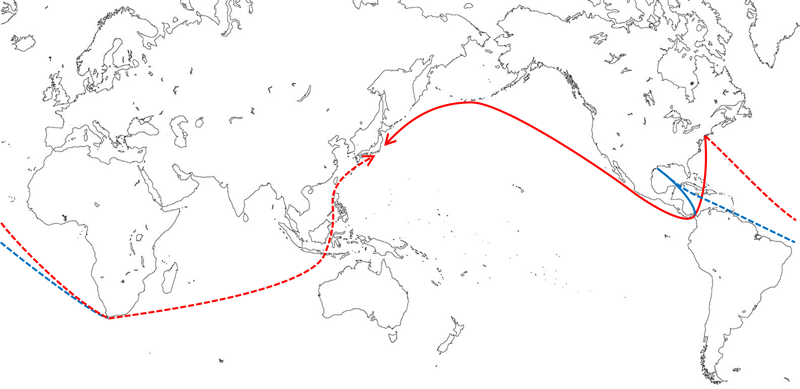
Source: Created by the author
*3 One nautical mile is 1,852 meters. Please refer to
“Let’s see the Routes and Speed of Cargo Ship” for more information.
Vessels and fees for passage through the Panama Canal
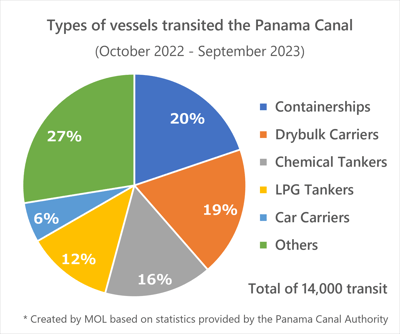 The Panama Canal Authority, which manages the Panama Canal, publishes the number and types of vessels that have transited the canal each year.
The Panama Canal Authority, which manages the Panama Canal, publishes the number and types of vessels that have transited the canal each year.
According to the most recent data available, the number of vessels that transited the Panama Canal in the Panamanian 2023 fiscal year (from October 2022 to September 2023) amounted to approximately 14,000 in total, combining both the Pacific to the Atlantic and the Atlantic to the Pacific transits.
Furthermore, the types of vessels that transited during this period were mostly containerships, accounting for about 20% of the total. This is followed by drybulk carriers that transport bulk cargo such as grain and coal, tankers that transport liquid cargo and liquefied gas, and car carriers.
The transit fee for the Panama Canal varies depending on the type of vessel, but according to the table of fees announced by the Panama Canal Authority (as of February 2024), the transit fee for a Neo-Panamax size containership is approximately 1.26 million dollars, and for a traditional Panamax size dry bulk ship it is about 190,000 dollars*4.
*4 A containership is assumed to carry 14,000 containers (90% utilization), and a dry bulk carrier is assumed to carry 80,000 deadweight tons (when loaded with cargo). In addition to the transit fee, various other charges are required to transit the canal. Also, a discount on the transit fee is set if certain conditions are met.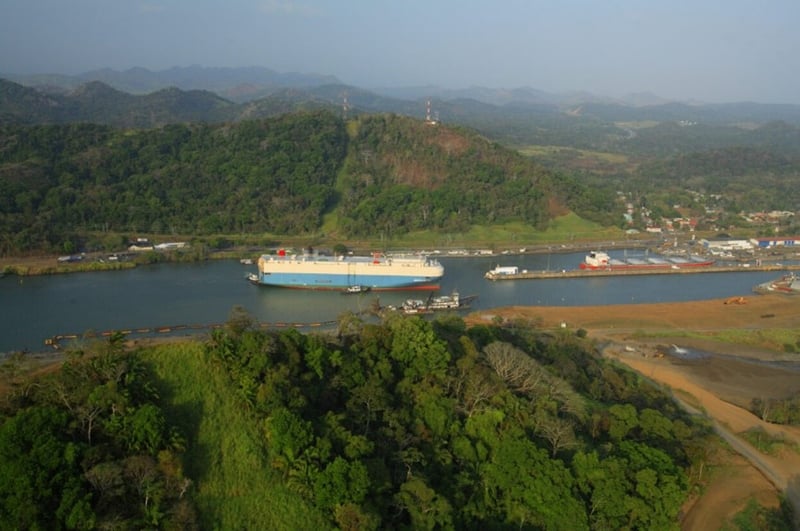 MOL pure car carrier transit through the Panama Canal
MOL pure car carrier transit through the Panama Canal
Panama Canal Transit Restrictions
In Panama, the rainy season falls between May and December each year. The Panama Canal uses the large amount of rainwater that falls during the rainy season, damming it in Lake Gatun. In years past when rainfall is low and the water level of Lake Gatun is consequently low, measures have been taken to limit the draft of vessels transiting the canal.
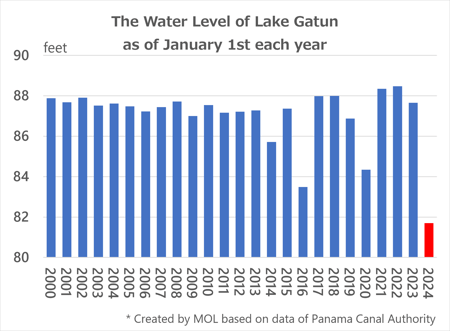 In recent years Panama has experienced a significant decline in rainfall, and in particular, 2023 was hit by a record-breaking water shortage, considered the worst in 100 years, partly due to the effects of the El Niño phenomenon. Therefore, in addition to limiting the draft of vessels transiting the Panama Canal, the Panama Canal was also forced to limit the number of vessels transiting per day.
In recent years Panama has experienced a significant decline in rainfall, and in particular, 2023 was hit by a record-breaking water shortage, considered the worst in 100 years, partly due to the effects of the El Niño phenomenon. Therefore, in addition to limiting the draft of vessels transiting the Panama Canal, the Panama Canal was also forced to limit the number of vessels transiting per day.
In August 2023, it was reported that over 200 vessels were waiting to transit the canal. As a result, many vessels that had traditionally transited the Panama Canal were forced to either prepare for a long wait to transit or change their route to go around the Cape of Good Hope, resulting in an increase in sailing distance and days.
The transit restrictions of the Panama Canal have continued into 2024, and as of February 2024, the number of vessels transiting per day is limited to 24, which is just under 70% of the usual number.
In Panama, plans are being made to dam the Rio Indio River, which flows from the mountains of Panama to the Caribbean Sea, to create a new reservoir and pump a large amount of water into Lake Gatun in order to fundamentally solve the water shortage problem of the Panama Canal. However, the construction requires a huge amount of money, and there are difficult issues such as the relocation of residents in the planned construction area and environmental problems. Currently, there is still no clear timeline for the realization.
As mentioned at the beginning, the Panama Canal, which connects the Pacific and Atlantic Oceans, is truly a "choke point" for maritime transport, and restrictions in the Panama Canal usage have had a significant impact on global supply chain. With the effects of the recent global climate change, there are concerns that Panama's water shortage may become even more severe in the future, and it is therefore necessary to carefully monitor this trend.
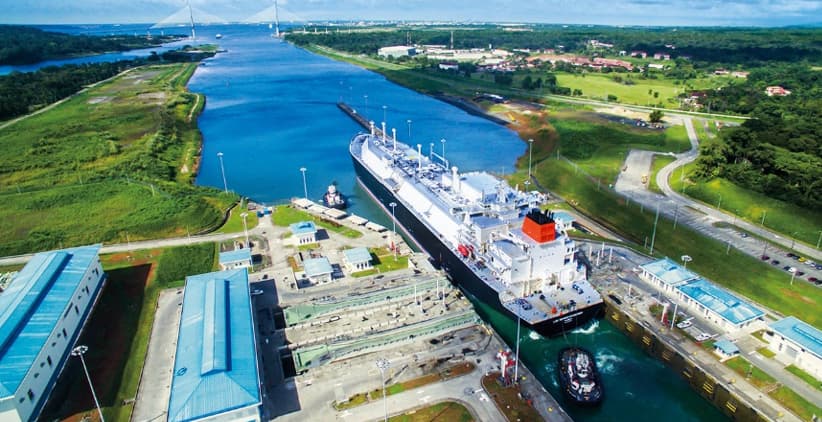

Writer:Takahiro
Joined the company in 1991. A man in his 50s has experienced in dry bulk shipping, crude oil and petroleum product tanker shipping, and fuel oil procurement for our operated ships before he transferred to market research. Recently he gains excess belly fat probably because he had been involved in oil-related businesses for a long time...
Recommended Articles
2022.07.05
- General Shipping
2021.04.13
- Energy
2023.12.19
- General Shipping
2021.08.07
- Eco Friendly
2025.03.18
- General Shipping
Latest Articles
2025.12.09
- Eco Friendly
- General Shipping
2025.12.03
- General Shipping
2025.11.20
- Energy
- General Shipping

